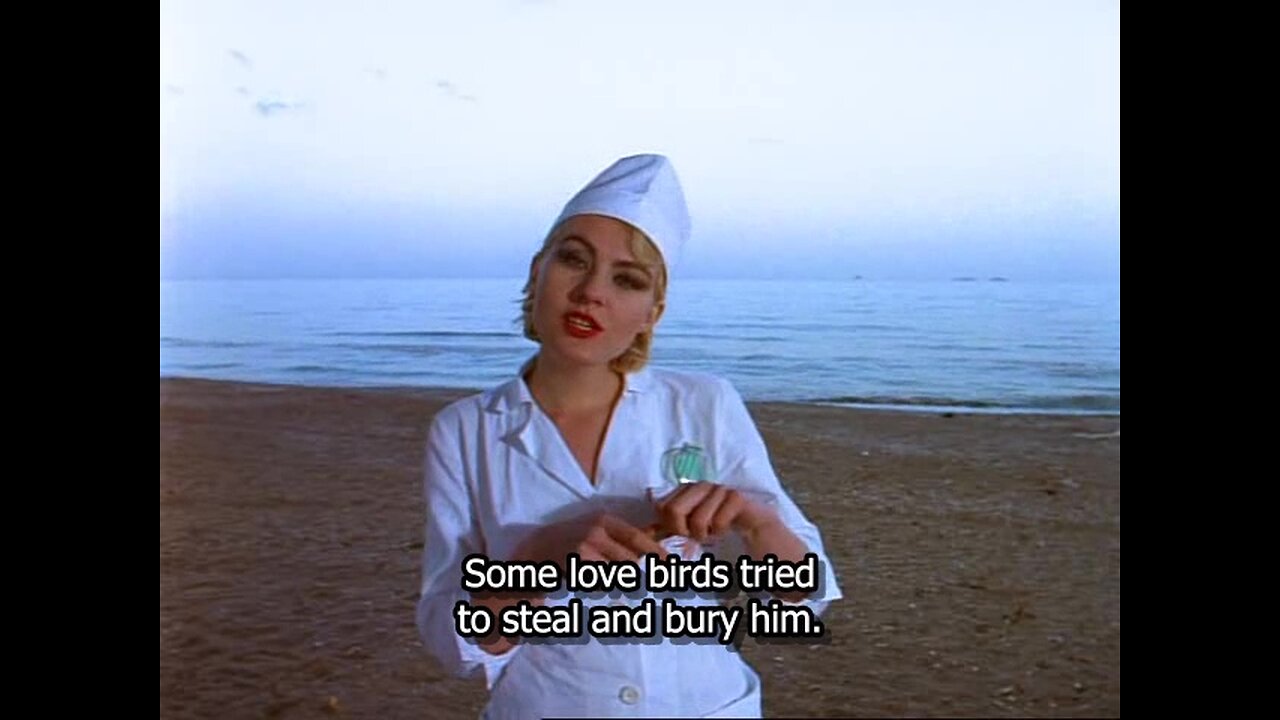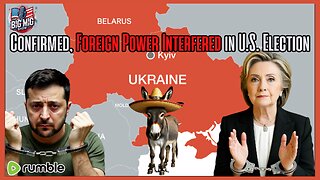Premium Only Content

"Passions" ( Kira Muratova - "Uvlecheniya", 1994 )
"Passions" ( "Uvlecheniya", 1994 )
Director: Kira Muratova
A jockey and a circus performer meet in a hospital, and then we see not so much a consistent plot but a mosaic of human passions. The true nature of passion itself revealed in this bright and beautiful movie.
https://www.imdb.com/title/tt0111583/
_ _ _
Passions, whose title (Russian: Увлеченья, romanized: Uvlechenya) can also be translated "Enthusiasms," is a 1994 drama by Ukrainian director Kira Muratova based on the novellas of Boris Dedyukhin.
It was screened at the Locarno Festival in 1994.
It received two Nika Awards, for Best Picture and Best Director (Muratova). The picture also won the Special Jury Prize of the Kinotavr film festival.
The film's story unfolds in a small town on the beach. Two females: a blonde - Lilia and a brunette - Violetta, are fond of horse racing and the jockeys are fond of the women. Star jockey Oleg Nikolaev teaches Violetta horse riding and another horseman who is also interested in the same girl, summons Oleg Nikolayev to a duel.
https://en.wikipedia.org/wiki/Passions_(1994_film)
_ _ _
"Passions"
Passions is considered Muratova’s most unusual film, the one which, at least on the surface, seems to have the least to do with her considerable body of work; paradoxically, it was one of her most popular films in Russia, even winning the Nika (Russia's Oscar equivalent) for the Best Film of 1994. Circus performer Violetta is introduced to Sasha, a jockey who has been hospitalized after a bad fall. She's attracted to him, and even more to his circle of friends, becoming fascinated with their devotion to horses and the lore of horseracing. She decides to go visit her new friends on a stud farm in Central Asia; ostensibly for the purpose of finding a partner for a new horse act she hopes to bring to the circus, but perhaps more honestly just to learn more about them and their world. Laced with a slightly surreal quality, Passions is an effective and perceptive portrait of a kind of subculture, a world that seems to co-exist alongside everyday reality and to blend with it on occasion. Muratova has spoken about how much she enjoyed the chance to work extensively with animals - seemingly one of her own great passions- in the film.
https://www.peramuseum.org/Film/Passions/865/153
_ _ _
"PASSIONS"
“The unconventional, personal and arty film is not for everyone.”
Reviewed by Dennis Schwartz
The strange plot-less post-Soviet film by Ukrainian indie filmmaker Kira Muratova(“The Tuner”/”Chekhov’s Motives“/”Second Class Citizens“), once known as the cinema bad girl in the USSR, now allowed to do her madcap irritating surrealist thing of making films by breaking the rules of logic without interference, is a film that I’m willing to wager will turn off more Americans than turn on. It won a Nika in Russia for Best Film. The photography is delicious, the many references to literature are tantalizing and the pic bizarrely raises oddball questions about the love for horses in comparison to the foolish love of sportsmen for pretty young women. One of its many bold statements that challenges the conventional wisdom of the day and defies the viewer to accept it on its own terms is when it bellows out its theme that “Beauty always strives for self-destruction.”
Passions is set at a seaside hospital and at a lush horse farm among a bunch of chatty Fellini-like character onlookers, who are intensely engaged throughout in a gabfest about such things as beauty, horses, the circus, centaurs and love. An often repeated question, one that’s never answered, is raised among the sporting experts about “Who wins the race, the jockey or the horse?”
The flighty blonde nurse Lila (Renata Litvinova) attends a wounded jockey and calls herself “A flower above and below water.” The brunette Violetta (Svetlana Kolenda) is a vain circus performer, who can’t fully accept being told over and over by jockeys and trainers that “the circus horse is inferior to the thoroughbred” and that “Dogs are prose and horses are poetry.”
The unconventional, personal and arty film is not for everyone, as Muratova’s artful way of showing love to the horses and getting at the intrigues found in horse racing demand that the viewer bet everything on her opinions winning the wager. It’s likable for the rich racing atmosphere created and the feeling that all its silly idiosyncratic touches might actually lead to something rewarding if pondered in a serious way.
https://dennisschwartzreviews.com/passions/
_ _ _
"Passions"
(Kira Muratova, Russia, 1994)
How Strange the Change (from Major to Minor)
If you want to know the truth, here it is. If you want me to invent something more complicated, I can try.
– Kira Muratova, 2002 (1)
In English, the Russian title Uvlecheniya comes out three ways: as Passions (which sounds melodramatic and grand, which the film is not), Petty Passions (which sounds moralistic, which the film is not), and, most charmingly and matter-of-factly, Enthusiasms (which, unfortunately, will never fly as an English-language movie title).
Maybe Pretty Passions might do the trick, especially as it echoes the 1960s pre-Badlands story of mad criminal love Pretty Poison – and that could be the proper title of many Muratova films. Pretty Passion as an antidote to Pretty Poison; the positive side or shadow of the negative. Aha, a hook! – but a deceptive one.
Surveyors of Kira Muratova’s career tend to stumble over this one as a lightweight interlude, a “superficial” film in her career, reflecting some fleeting post-Glasnost of sustained cheer in Muratova’s (at the time) 60-year-old bosom, and unpredictably a relatively popular success; she herself, in her usual irritable and paradoxical way, countered that it was “deeply superficial”. And we must follow her exasperated, liberating lead.
The seductive, critical game of extreme points, of dialectics, of binary oppositions does not get us terribly far into Muratova. Commentators try in vain to divide her films into opposing groups, like: the plotless and the plotted; or the colour works and the black-and-white ones. As if this categorising gesture could somehow impose order on these films in their wild variety, from one to the next and within each one!
What is the plot of Passions? Neither plot nor theme swim into view within the first thirty minutes (which is the section I will concentrate on here). We dance – sometimes literally – from one point of interest to another, one enthusiasm to another. But always on a hinge, an overlap: it’s a cleaner, more minimal version of the chaos we see in Robert Altman or Emir Kusturica. But hardly a more logical method.
“Free association” comes to mind as a way to label her creative process, except that this free association (as free association is wont to do) comes complete with mind-bending repetitions, loops and metamorphoses. The words go around and around (a little in the way Pascal Bonitzer writes dialogues for Chantal Akerman or Raúl Ruiz); the gestures, too … Like Boris Barnet the Master, Muratova is the Mistress of the endlessly renewed, endlessly circulated, endlessly reinvented gesture.
As in a Chinese film of strenuously magic realism, The Sun Also Rises (Wen Jiang, 2007) – containing the apotheosis of another woman director-actor, Joan Chen, fifteen years after her iconic transformation in Lynch’s Twin Peaks – this means that Muratova is especially fond of pouty doll-women, impossibly beautiful marionettes (like Svetlana Kolenda and Renata Litvinova here), themselves miraculously hinged at every part of their body, twisting and turning and thrusting and dividing at the knees, waist, wrists, neck …
The chaos of Passions, knowingly or not, evokes Federico Fellini. But Fellini without a centre: without “the crisis of the artist” or “the loss of time, history and memory” or “the world as it changes from one era to another”. All enthusiasms in Muratova are small, minute, obsessive – even microscopic. They spin their web wonderfully, but don’t take up so much space. This is why she uses the hinge-overlap method: it’s a lapidary style, the webs join up and combine, extending in every direction. Every which way and loose.
Manny Farber used to slyly scoff at people who claimed to know what a film is about. Plot and theme are the two standard ways we corral the energy or ecology or wildness of a film – in the former, banally (“the film is about a horse-enthusiast colony”), in the second, either banally or ingeniously (“the film is about the life-force’s resistance in an oppressive social framework”). Filmmakers sometimes prefer to speak of the subject of a particular work, which is neither plot nor theme, exactly, but something more material and physical, something that can be dug into and explored: for Robert Bresson, the subject of Pickpocket is pickpocketing, which gives him a milieu to study and depict, an action to render (in all its movements and varieties), and some kind of mysterious passage to traverse (from the street to the prison cell, via the racetrack, the train station … ), the meaning of which is, ultimately, secretive and personal, rather than communicative in a town-hall “storytelling” way.
With Muratova, even the subject is obscure. That is why her commentators seize on what recurs (from film to film and within each film), on what fitfully coheres the elements that spin off from an evaporated centre: murder, depression, animals, children, sudden recitals of song of dance … But you know that Muratova has gotten right under the skin of her commentators, sending them mad, when they find themselves writing very truthful, free-associative things like: “Surface, paper, and the fictional self emerge as the organising principles of this film” (that’s Nancy Condee on The Tuner [2004]). (2) It is a contagion we critics must strive to emulate.
Passions proceeds through endless hair-splitting, impossible comparisons, expounded upon in the sing-song dialogue and enacted in the choreography of gesticulating and extravagantly (often idiotically) costumed bodies. And never a comparison between just two entities, but (thanks to the hinge method) at least three, and usually many more: in the initial dances through a little wood and over to a humble stretch of beach (with some possibly medical institution vaguely glimpsed but never entirely identified in the background), the skills of horse-riding are combatively compared to the acrobatic skills of the circus big-top; but then one or other or both are compared (via the introduction of doll-woman number 2, the Nurse-actress), as a method of healing, with health-care or psychiatry or medicine.
A little later, in the course of a wonderfully crammed lateral tracking shot following a gaggle of people, the concept of “pace” is endlessly posed as a question, receiving various theoretical and physical accounts: it’s a relative concept, it seems, a concept of relativity indeed, since it can only be gauged by the rider in flight, and yet that flight can so easily be interrupted or distracted. It’s clearly a model of the kind of movement in Muratova’s work itself.
We never can know the poles or points of Self and Other in Muratova, because they shift and change before our eyes – usually thanks to her other favourite device, the “reveal” of a part of space or a figure/object in space we have not previously viewed before the mid-scene pan or cut. In the second tableau-in-motion of Passions, set at the mysterious horse colony (are these horses being trained, collected, exhibited?), we are introduced to a slightly creepy, neurotic photographer (but then, all microscopic enthusiasms in Muratova are necessarily neurotic, it’s her and their “aesthetic syndrome”): it seems as if the doll-women are lining up, posing, to be shot by him, but by steps they pass out of his camera range – really, it’s the horses (or one special, especially glamorous and luminous horse) he wants to capture.
So we pass to the horse, to its magnificent visage. And now we seem to pass into this horse’s POV (why not? Bresson did it in Balthazar), watching a woman beginning to strip for him (the “him” is an associative hypothesis here). But the longer the shot remains in place, the less the POV seems stable or constant: the point of interest, as ever, is shifting, turning away, transforming – and thus so are all the point-to-point (human to human, human to animal, child to adult) relations forever set-up, taken apart and reconstituted. The mood-changes are just as constant, and just as sudden: from light to dark, gaiety to sadness, major to minor.
Who could possibly reconstruct a hierarchy of values from such a perplexing set of shifts and reversals? To an interviewer’s question about Chekhovian Motifs (2002) – “The film seems very poetic. How would you characterise its atmosphere?” – Muratova proudly and pre-emptively replies: “Your question is absolutely incorrect and illegitimate”, bothering to add: “I had no intention to convey any mood by means of my film ... I can’t define verbally the thing you call atmosphere. It would be too simple.” Intentions, definitions, schemas belong to critics and analysts; the work itself is an organic process of “separated parts” that “melt into something living”. (3)
Muratova follows her enthusiasms. (Her motto: “What is most important is to please myself” – not any imaginary collective audience or constituency.) It is strictly impossible to know, at any given point, what shape or significance they are going to take. They are all in flight, and the path of that flight can go literally anywhere. Of course, she loves all that is theatrical, artificial, histrionic. Her cinema is the cinema of everything you can see, every ball that can be suspended in the air and passed on to the next player (or clown).
Nothing hidden from view – except the underlying logic, the generating principle or matrix of the work (or her whole work). Like the manifestation of a dream or fantasy or reverie, all in a rush, no self-questioning or ‘secondary revision’ (Freud’s term). Acting out, as the pop psychologists of American film and TV say.
Kira Muratova acting out and – through her – private life, public life … plus film itself, in all its infinitely divisible, endlessly traceable, states and moods.
NOTES
1. Dmitry Desyaterik, “Kira Muratova: ‘What is Most Important to Me is to Please Myself’”, Russian Journal (11 September 2002); no longer online.
2. Nancy Condee, “Muratova’s Well-Tempered Scam", KinoKultura, no. 7 (January 2005),
https://www.kinokultura.com/reviews/R1-05tuner.html
3. Desyaterik, Muratova interview.
© Adrian Martin 13 September 2008
https://adrianmartinfilmcritic.com/reviews/p/passions.html
_ _ _
-
 LIVE
LIVE
The Rubin Report
58 minutes agoListen to ‘The View’ Crowd Gasp as Whoopi Tells Super Bowl Crowd to Do This
1,433 watching -
 LIVE
LIVE
LFA TV
13 hours agoLIVE & BREAKING NEWS! | TUESDAY 10/7/25
3,915 watching -
 1:00:59
1:00:59
VINCE
2 hours agoWho Else Were They Spying On? | Episode 141 - 10/07/25
157K80 -
 1:46:37
1:46:37
Dear America
3 hours agoBIDEN FBI CAUGHT SPYING!! Jack Smith Tracked Calls of DOZENS Of Senators!! JAIL NOW!!
82.1K43 -
 LIVE
LIVE
Badlands Media
7 hours agoBadlands Daily: October 7, 2025
3,653 watching -
 LIVE
LIVE
The Big Mig™
2 hours agoConfirmed, Foreign Power Interfered in U.S. Election
5,423 watching -
 LIVE
LIVE
The State of Freedom
5 hours ago#339 Local Justice & A National Awakening
16 watching -
 25:19
25:19
Rethinking the Dollar
1 hour agoTuesday Morning News Update: Let's Talk...
9.64K4 -
 54:18
54:18
JULIE GREEN MINISTRIES
2 hours agoLIVE WITH JULE AND TIM BALLARD
19.4K77 -
 LIVE
LIVE
Viss
2 hours ago🔴LIVE - Acquire PUBG Tactics Acquire Chicken Dinners! - PUBG 101
69 watching
